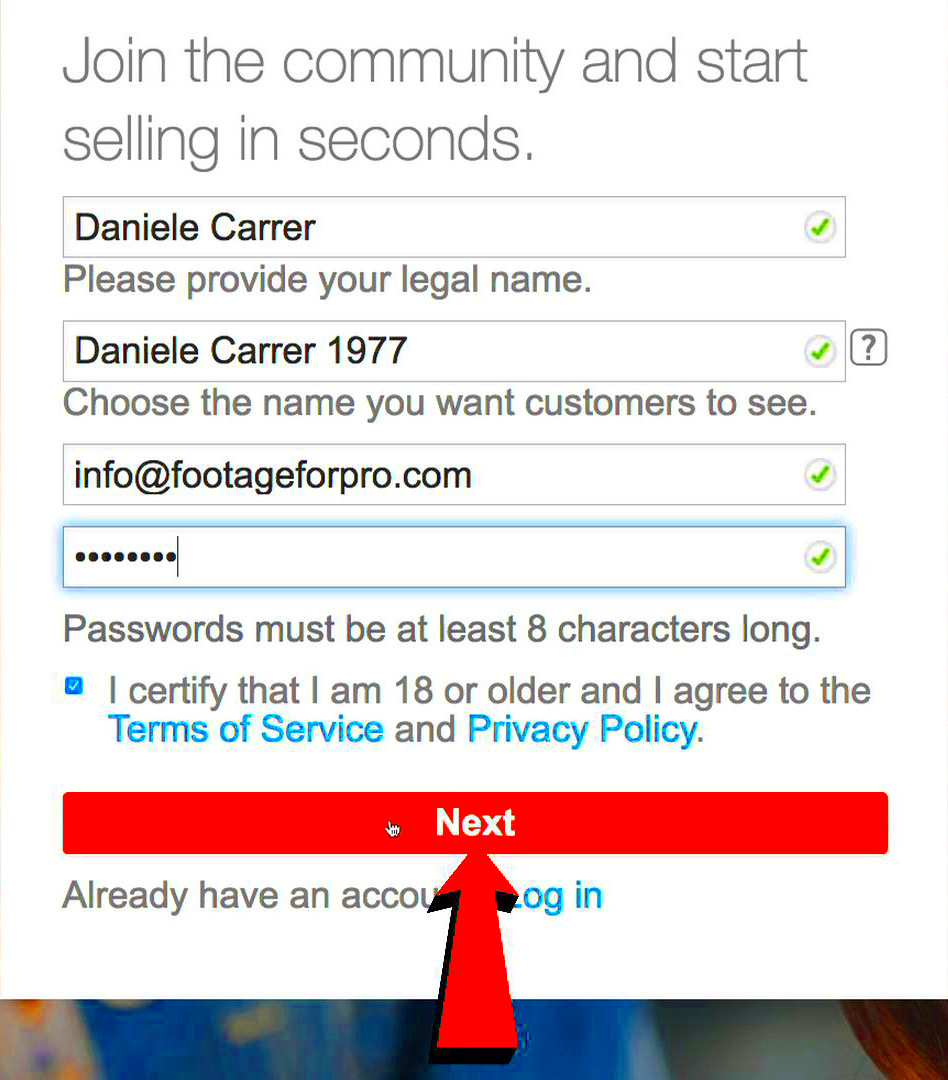It sounds really frightening to be a Shutterstock contributor yet its remarkably doable when you satisfy the major necessities that the platform looks at. When dealing with contributors, Shutterstock is after such persons who will continuously give them high quality videos as well as good pictures and vectors. This way, they get professional type of material which attracts clients from around the world.
What are the minimum requirement that you should be aware of:
- Age: You must be at least 18 years old to apply.
- Content Quality: Submissions should be sharp, properly exposed, and free from any visual defects.
- Ownership: You should own the rights to all content you submit.
- Ethical Considerations: Your submissions should follow copyright laws, especially for commercial use.
The first step to entry into Shutterstock’s wide contributor network is meeting these requirements. The website requires a lot and even though it is competitive, you will be able to meet its standards with the right strategy.
Steps to Apply as a Shutterstock Contributor

Becoming a Shutterstock contributor isn’t much of a hassle; however, if you want to avoid unnecessary delays in your approval, ensure that you are observant and follow every step carefully. Below is a simple guide listing the application procedures:
- Create a Shutterstock Account: Head to the Shutterstock contributor page and sign up for a new account. You’ll need to provide some basic information.
- Upload Sample Content: Shutterstock will ask for a few samples of your work. These will be evaluated based on quality, originality, and adherence to guidelines.
- Submit Personal Information: You’ll be required to submit personal details, including your name, location, and payment information for future earnings.
- Wait for Review: Once you’ve submitted your content and details, Shutterstock will review your application. This process can take anywhere from a few days to a week.
- Approval or Rejection: If approved, you’ll gain access to upload more content. If rejected, you’ll receive feedback on why and what to improve.
Thus, if you adhere to these instructions carefully, you shall be an evident contributor to Shutterstock. Although the application procedure is meant to be seamless; yet, adequate preparation is important.
Also Read This: Using Storyblocks on Windows 10: How-To
Common Reasons for Application Rejection

Although it may be annoying to have your application for becoming a contributor to Shutterstock rejected, it is usually due to preventable reasons. There are standards put in place by Shutterstock and not meeting them means a straight rejection. What are the usual mistakes? The following guide will help you dodge these mistakes when making your application.
There are some typical reasons why applications get rejected:
- Low-Quality Images: Photos that are blurry, poorly lit, or have excessive noise are major red flags. Shutterstock values clarity and professionalism in its library.
- Copyright Issues: Submitting content that includes logos, branded items, or recognizable faces without proper releases can lead to rejection.
- Poor Composition: Even if your images are technically sound, poor composition or lack of visual appeal can lead to a rejected application.
- Metadata Problems: Incorrect or missing metadata, such as titles, descriptions, or keywords, may prevent your application from being accepted.
- Too Few Samples: Submitting too few or the wrong type of content (e.g., sending only one image when more are requested) can result in automatic rejection.
If your application gets rejected don’t be disheartened. Shutterstock basically provides feedback most times, which can help you improve on the necessary areas before you can apply again.
Also Read This: Exploring Creative and Fun DIY Videos Available on Dailymotion
How to Improve Your Chances of Approval
When it comes to being approved as a Shutterstock contributor, you must focus on quality and preparation. Their content offerings are quite broad but their approval process can be quite stringent. By making a few additional efforts, you can increase your chances of getting accepted considerably.
Here are a few practical tips for enhancing your chances:
- Submit High-Quality Content: Quality is key. Make sure your photos or videos are sharp, well-lit, and free from noise or other visual defects. Invest in good editing software to fine-tune your submissions.
- Follow Guidelines Closely: Shutterstock has strict submission guidelines. Before uploading, double-check for size, resolution, and format requirements. Avoid oversaturation or unnatural colors.
- Research Market Trends: Look at what’s trending on Shutterstock. By understanding what sells, you can tailor your content to meet current demands.
- Get Model and Property Releases: If your images feature recognizable people or private property, you’ll need to provide proper release forms. This can make a big difference in getting approved.
- Check for Copyright Issues: Ensure that your content doesn’t include copyrighted materials like logos, famous landmarks, or artwork. Shutterstock is strict about intellectual property.
These simple steps will help you represent yourself as an expert content creator which can definitely make a difference during your application.
Also Read This: Does Opera GX Block YouTube Ads and Explore Its Features
Tips for Building a Strong Shutterstock Portfolio
After getting an approval, it is important to have an engaging portfolio in order to attract customers. Having a well-designed portfolio will enhance one’s chances of selling more and getting known on Shutterstock’s platform. The aim should be to make a varied, excellent stock that can solve different customer needs.
These is the way for constructing a powerful portfolio on Shutterstock:
- Focus on Niche Topics: While variety is important, specializing in a particular niche can set you apart. Whether it’s nature photography, cityscapes, or abstract art, find a style that defines your brand.
- Upload Consistently: Shutterstock favors active contributors. Uploading regularly helps keep your portfolio fresh and visible. Aim for at least a few new uploads every week.
- Tag Your Content Properly: Keywords are crucial. Add detailed and accurate keywords to ensure your content gets found in searches. Think about what buyers would search for when tagging your work.
- Offer Variety in Content Types: Don’t limit yourself to one type of media. Experiment with photos, illustrations, vectors, and even videos to reach a wider audience.
- Study Top Contributors: Look at successful contributors in your niche. Analyze what works for them—whether it's the subject matter, composition, or style—and apply those insights to your work.
A continuous journey is creating a balanced collection of works. Devotion and imagination will help feed your collection until it stands as an alternative source of revenue.
Also Read This: Creating a Beautiful Flower Vase from a Plastic Bottle
What Happens After Getting Approved?
Once you make it through the approval process as a Shutterstock contributor, that’s when the main part of your journey starts! In this case, it means starting to upload content, communicating with the platform, and more likely selling them. Knowing what to expect post-approval can give you an edge and enable you to exploit your contributor account fully from day one.
Below are your expectations:
- Access to the Contributor Dashboard: Once approved, you’ll get access to a dashboard where you can manage your uploads, view earnings, and track sales statistics.
- Uploading Content: You can start uploading images, videos, and vectors. Each submission will go through a quality review, just like your initial application, to ensure it meets Shutterstock's standards.
- Earnings and Payments: As buyers purchase your content, you’ll start earning royalties. Shutterstock pays out earnings monthly, as long as you reach the minimum payout threshold.
- Continuous Feedback: If any of your uploads are rejected, Shutterstock provides feedback. Use this as a learning opportunity to improve future submissions.
- Growing Your Portfolio: You’ll want to continuously add new content to keep your portfolio active and attract more buyers. The more content you upload, the greater your potential for sales.
You just start when you get approved. Staying active and following best practices is the key to success in Shutterstock.
Also Read This: How to Determine If You're Shadowbanned on YouTube
Frequently Asked Questions
Both you and the applicants desire to join Shutterstock as contributors have asked them similar questions. Here are some popularly asked questions with answers that will help explain the procedure:
| Question | Answer |
|---|---|
| Do I need professional equipment to get approved? | No, you don't need expensive cameras or gear. What matters most is the quality of your images or videos. Even smartphones with good cameras can produce acceptable results if used correctly. |
| How long does the approval process take? | After submitting your application, the review process can take anywhere from a few days to about a week. Shutterstock will notify you via email once a decision is made. |
| What happens if my application is rejected? | If your application is rejected, Shutterstock will provide feedback on what needs improvement. You can reapply after making the necessary changes to your work. |
| Can I sell the same content on other platforms? | Yes, Shutterstock allows non-exclusive submissions, meaning you can sell the same content on other stock photography sites unless you opt for exclusive licensing with Shutterstock. |
| What types of content sell best? | Content that is commercial-friendly, such as business-related images, lifestyle shots, and technology-focused visuals, tends to perform well. However, niche content can also find its market if it’s high-quality. |
This should make those potential contributors comfortable as they consider applying and starting with Shutterstock by understanding those frequently asked questions (FAQs).
Conclusion and Final Thoughts
For content creators who are willing to work hard, being a Shutterstock contributor can be a fulfilling experience. If you understand what the platform requires, stick to the procedures, and keep sharpening your content over time, you will find yourself on Shutterstock making money from your talent. Patience is important; whenever you run into challenges, learn from them and keep trying to make your submissions better.
